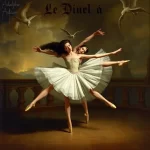Ballet: Le Corsaire (Adolphe Adam, 1856)

Introduction
Le Corsaire is a classic ballet that has captivated audiences since its premiere in 1856. Composed by Adolphe Adam and choreographed by Joseph Mazilier, this ballet is a tale of adventure, romance, and heroism set against the backdrop of the high seas and exotic lands. The ballet premiered at the Théâtre Impérial de l’Opéra in Paris on January 23, 1856, and has since become a staple in the repertoire of ballet companies worldwide.
The plot of Le Corsaire revolves around the daring pirate Conrad, who falls in love with Medora, a beautiful slave girl. The story unfolds with thrilling rescues, dramatic confrontations, and a series of captivating dances that highlight the ballet’s themes of love, bravery, and freedom.
Historical Background
Creation and Development
Le Corsaire was created during a period of significant artistic and social change in mid-19th century Europe. The Romantic era, characterized by an emphasis on emotion, individualism, and the sublime, heavily influenced the arts, including ballet. The ballet was inspired by Lord Byron’s 1814 poem “The Corsair,” which tells the story of a pirate’s adventures and his love for a beautiful woman.
Adolphe Adam, a prolific composer known for his work in ballet and opera, collaborated with choreographer Joseph Mazilier to bring this story to life on stage. Mazilier, a prominent figure in the Parisian ballet scene, was known for his innovative choreography and ability to create dramatic, narrative-driven ballets. Together, they crafted a work that combined thrilling action with expressive dance, set to a richly orchestrated score.
Premiere and Reception
Le Corsaire premiered on January 23, 1856, at the Théâtre Impérial de l’Opéra in Paris. The initial reception was mixed, with some critics praising the ballet’s dramatic elements and choreography, while others found the plot convoluted. However, the ballet quickly gained popularity with audiences, thanks in part to its spectacular staging and the virtuosity of its dancers.
Notable early performances included revivals by Marius Petipa, who made significant revisions to the choreography and expanded the ballet’s scope. Petipa’s version, first staged in St. Petersburg in 1868, became the definitive interpretation and solidified Le Corsaire‘s place in the ballet canon.
Synopsis of the Ballet
Act I Summary
The ballet opens in a bustling marketplace where Medora, a beautiful slave girl, is being sold by the slave trader Lankendem. Conrad, a dashing pirate, sees Medora and falls in love with her at first sight. He decides to rescue her from her fate. With the help of his fellow pirates, Conrad kidnaps Medora and takes her to his ship. The act ends with a dramatic escape as the pirates fend off Lankendem and his men.
Act II Summary
On the pirate ship, Conrad and Medora declare their love for each other. However, their happiness is short-lived as the treacherous Birbanto, one of Conrad’s men, plots to betray him. Birbanto incites a mutiny, and in the ensuing chaos, Medora is recaptured by Lankendem. Conrad, determined to save her, sets off in pursuit.
Act III Summary
The final act takes place in the luxurious palace of the Pasha, where Medora is being held captive. Conrad and his pirates infiltrate the palace in disguise. A series of dramatic confrontations ensue, culminating in a thrilling rescue. Conrad and Medora escape, reaffirming their love and freedom as the ballet concludes with a triumphant finale.
Finale
The conclusion of Le Corsaire is marked by the reunion of Conrad and Medora, symbolizing the triumph of love and bravery over adversity. The ballet’s finale is a celebration of freedom and the enduring power of love, leaving audiences with a sense of exhilaration and hope.
Musical Composition
Composer’s Role
Adolphe Adam, a renowned composer of the Romantic era, played a crucial role in shaping the musical landscape of Le Corsaire. Known for his ability to create evocative and memorable melodies, Adam’s score for the ballet is both dramatic and lyrical, perfectly complementing the action on stage. Notable pieces within the score include the lively “Pas d’Esclave” and the hauntingly beautiful “Le Jardin Animé.”
Musical Themes and Motifs
The music of Le Corsaire is characterized by recurring themes and motifs that enhance the narrative and emotional depth of the ballet. For example, Conrad’s theme is bold and heroic, reflecting his character’s bravery and determination. In contrast, Medora’s theme is tender and lyrical, underscoring her innocence and beauty. These musical elements help to create a rich, immersive experience for the audience.
Famous Recordings and Performances
Over the years, there have been numerous recordings and performances of Le Corsaire‘s music. One of the most iconic recordings is by the Bolshoi Ballet Orchestra, conducted by Alexander Kopylov. This recording captures the energy and emotion of Adam’s score, making it a favorite among ballet enthusiasts. Additionally, performances by renowned ballet companies such as the Bolshoi Ballet and the Mariinsky Ballet have brought the music of Le Corsaire to life on stage.
Choreography and Dance
Choreographer’s Vision
Joseph Mazilier’s original choreography for Le Corsaire was groundbreaking in its use of dramatic storytelling and expressive dance. Mazilier sought to create a ballet that was both visually stunning and emotionally engaging, using innovative techniques to convey the story’s themes of love, adventure, and heroism. His choreography combined classical ballet with elements of folk dance and pantomime, resulting in a dynamic and captivating performance.
Signature Dance Numbers
One of the most famous dance numbers in Le Corsaire is the “Pas de Deux” between Conrad and Medora. This duet is a showcase of technical prowess and emotional expression, highlighting the chemistry between the two characters. Another notable scene is the “Le Jardin Animé,” a dreamlike sequence in which Medora envisions herself in a beautiful garden. This scene is renowned for its intricate choreography and stunning visual effects.
Notable Interpretations
Over the years, different productions of Le Corsaire have interpreted the choreography in various ways. Marius Petipa’s revisions in the late 19th century added new layers of complexity and grandeur to the ballet, making it a favorite among Russian ballet companies. In more recent times, choreographers such as Anna-Marie Holmes have created new versions that blend traditional elements with contemporary sensibilities, ensuring that Le Corsaire remains relevant and exciting for modern audiences.
Characters and Roles
Main Characters
- Conrad: The heroic pirate captain who falls in love with Medora. He is brave, determined, and willing to risk everything to save her.
- Medora: A beautiful slave girl who captures Conrad’s heart. She is kind, gentle, and resilient, embodying the ballet’s themes of love and freedom.
- Birbanto: Conrad’s treacherous second-in-command who plots to betray him. He is cunning and ruthless, serving as the primary antagonist.
- Lankendem: The slave trader who sells Medora and later recaptures her. He is greedy and unscrupulous, driven by profit.
- The Pasha: A wealthy and powerful ruler who buys Medora and keeps her in his palace. He is portrayed as both comical and menacing.
Supporting Characters
- Gulnare: Another slave girl who befriends Medora and helps her escape.
- Ali: Conrad’s loyal friend and fellow pirate who assists in the rescue missions.
- Seid Pasha: A minor character who serves as an ally to the Pasha.
Famous Dancers
Many renowned dancers have portrayed the roles in Le Corsaire over the years. Notable performers include Rudolf Nureyev as Conrad, Natalia Makarova as Medora, and Mikhail Baryshnikov as Ali. These dancers brought their unique interpretations and technical brilliance to the ballet, leaving a lasting impact on its legacy.
Cultural and Artistic Impact
Influence on Ballet and Dance
Le Corsaire has had a significant influence on the world of ballet and dance. Its combination of dramatic storytelling, expressive choreography, and memorable music set a new standard for narrative ballets. The ballet’s success inspired other choreographers to explore similar themes and techniques, contributing to the development of ballet as an art form.
Cultural Significance
The ballet’s themes of love, adventure, and heroism have resonated with audiences for generations, making it a beloved work in popular culture. Le Corsaire has been adapted into various forms, including film, theater, and literature. Its enduring popularity is a testament to its universal appeal and timeless storytelling.
Legacy and Revivals
Le Corsaire continues to be performed and celebrated by ballet companies around the world. Major revivals by companies such as the Bolshoi Ballet and the Mariinsky Ballet have kept the ballet alive for new generations of audiences. Modern adaptations and reinterpretations have also ensured that Le Corsaire remains relevant and exciting in contemporary times.
Iconic Productions
Historic Productions
One of the most famous historical productions of Le Corsaire was Marius Petipa’s 1868 revival in St. Petersburg. Petipa’s version expanded the ballet’s scope and added new choreography, making it a definitive interpretation. Key figures involved in this production included principal dancers such as Ekaterina Vazem and Lev Ivanov.
Contemporary Productions
Recent productions of Le Corsaire have brought fresh perspectives to the ballet while honoring its traditional elements. The American Ballet Theatre’s 1998 production, staged by Anna-Marie Holmes, is a notable example. This version incorporated new choreography and modern staging techniques, making it accessible to contemporary audiences.
Production Design
The set, costume, and lighting design in various productions of Le Corsaire have played a crucial role in bringing the story to life. Historic productions often featured elaborate sets and opulent costumes that reflected the exotic locales and dramatic action. Contemporary productions have continued this tradition, using innovative design elements to enhance the visual impact of the ballet.
Critical Reception and Reviews
Initial Critical Response
At the time of its premiere, Le Corsaire received mixed reviews from critics. Some praised the ballet’s dramatic elements and choreography, while others found the plot convoluted. However, the ballet quickly gained popularity with audiences, thanks to its spectacular staging and the virtuosity of its dancers.
Modern Reviews
Contemporary critics and audiences continue to appreciate Le Corsaire for its thrilling action, expressive choreography, and memorable music. The ballet’s enduring popularity is a testament to its universal appeal and timeless storytelling. Modern reviews often highlight the technical brilliance of the dancers and the innovative staging techniques used in recent productions.
Fun Facts and Trivia
Behind-the-Scenes Stories
One interesting anecdote from the production of Le Corsaire involves the famous dancer Rudolf Nureyev. During a performance in the 1960s, Nureyev’s costume malfunctioned, causing him to improvise on stage. His quick thinking and professionalism turned a potential disaster into a memorable moment for the audience.
Notable Performers
Many famous dancers have been associated with Le Corsaire over the years. In addition to Rudolf Nureyev, other notable performers include Natalia Makarova, Mikhail Baryshnikov, and Alina Cojocaru. These dancers brought their unique interpretations and technical brilliance to the ballet, leaving a lasting impact on its legacy.
Trivia
- Adolphe Adam: In addition to composing Le Corsaire, Adolphe Adam is also known for his famous ballet Giselle.
- Multiple Versions: There are several versions of Le Corsaire, with different choreographers adding their own interpretations and revisions over the years.
- Exotic Setting: The ballet’s exotic setting and adventurous plot were inspired by the Romantic fascination with the Orient and tales of piracy.
Conclusion
Summary of the Ballet’s Importance
Le Corsaire is a significant work in the world of ballet, known for its thrilling action, expressive choreography, and memorable music. Its themes of love, adventure, and heroism have resonated with audiences for generations, making it a beloved work in popular culture. The ballet’s influence on other works and its role in the development of ballet as an art form cannot be overstated.
Final Thoughts
Le Corsaire remains a timeless classic that continues to captivate audiences with its dynamic storytelling and stunning performances. Whether you are a seasoned ballet enthusiast or a newcomer to the art form, experiencing Le Corsaire is a journey into a world of romance, adventure, and artistic brilliance. We encourage readers to watch a performance or listen to the score to fully appreciate the magic of this iconic ballet.
FAQ
What is the central theme of this ballet?
The central theme of Le Corsaire is the triumph of love and bravery over adversity. The ballet explores themes of romance, adventure, and heroism through its captivating story and expressive choreography.
Who are the main characters in this ballet?
The main characters in Le Corsaire are Conrad, the heroic pirate captain; Medora, the beautiful slave girl; Birbanto, Conrad’s treacherous second-in-command; Lankendem, the slave trader; and the Pasha, a wealthy ruler.
What is the most famous dance number in this ballet?
One of the most famous dance numbers in Le Corsaire is the “Pas de Deux” between Conrad and Medora. This duet is a showcase of technical prowess and emotional expression, highlighting the chemistry between the two characters.
How long does a typical performance of this ballet last?
A typical performance of Le Corsaire lasts approximately two to two and a half hours, including intermissions. The ballet is usually performed in three acts.
Are there any modern adaptations of this ballet?
Yes, there are several modern adaptations of Le Corsaire. Choreographers such as Anna-Marie Holmes have created new versions that blend traditional elements with contemporary sensibilities, ensuring that the ballet remains relevant and exciting for modern audiences.
Why is this ballet considered important in the history of dance?
Le Corsaire is considered important in the history of dance because of its innovative choreography, dramatic storytelling, and memorable music. The ballet set a new standard for narrative ballets and has had a significant influence on other works and choreographers. Its enduring popularity and continued performances are a testament to its lasting impact on the world of ballet.





